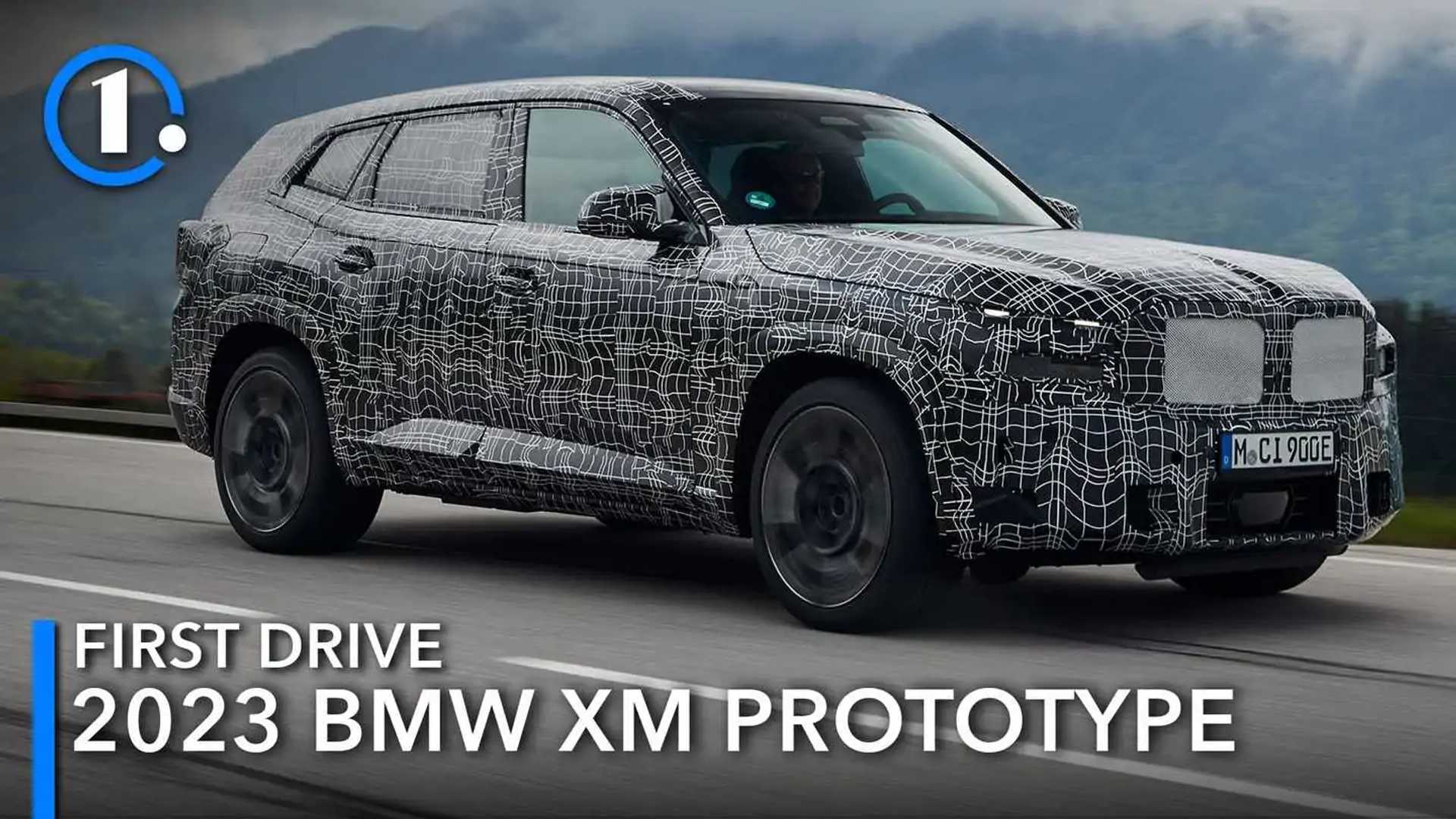
On May 24, 2022, BMW M GmbH will celebrate its 50th birthday. And as that day approaches, the outfit is finalizing work on only the second M-specific product since the legendary 1978 BMW M1. There's been much ado about the shape and controversial styling of that vehicle, the 2023 BMW XM, but after driving a camouflaged development prototype (that was around 90 percent ready for production), I'd like to suggest you all shut your faces.
No, I don't think it will look very pretty in production form (hello split headlights). And purists might prefer something other than a crossover. But strip away these quibbles and the XM is the best and truest M product in many years. In fact, it could well be my favorite M car since the E92 M3. That's not because it's stupendously fast or agile or aggressive – it's none of those things, really. What the XM is (and what every M product should be) is a vehicle that puts the driver's enjoyment, engagement, and comfort first. It's a return to form, like M cars of old, and something I hope we continue to see from M GmbH going forward.
| Quick Stats | 2023 BMW XM Prototype |
| Engine: | Twin-Turbocharged 4.4-liter V8 |
| Output: | 644 Horsepower / 650 Pound-Feet |
| 0-60 MPH: | 3.5 Seconds (est) |
| EV Range: | 30 Miles (est) |
| Base Price: | $130,000 (est) |
Gallery: 2023 BMW XM Prototype: First Drive







Many Firsts And One Big Second
Along with being only the second standalone BMW M product, the XM is also the subsidiary's first plug-in hybrid, the BMW Group's first V8-powered PHEV, and the first product to use the new S68 engine. A variant of the twin-turbocharged 4.4-liter V8 we know and love, the S68 was designed for plug-in applications and works alongside an electric motor sandwiched within the XM-specific, torque-converter-less ZF 8HP transmission to produce 644 horsepower and 650 pound-feet of torque (or less than the Concept XM's 750 hp and 737 lb-ft, which will eventually arrive later in 2023).
BMW was rather cagey on motor/battery specifics. The fifth-generation magnet-free electric motor's output is unknown, and BMW refused to provide details on the size of the lithium-ion battery pack or its EPA-estimated range, although I'm betting on around 30 miles to a charge based on the 50-mile WLTP range promised at the XM Concept's debut.


Staying on the topic of electronics, the XM is the first M product to carry active anti-roll bars with a 48-volt electrical architecture and the first to get rear-axle steering. But these thoroughly modern items are, like the XM, not what I'd normally expect. For a start, the rear-axle steering only turns up to 2.5 degrees and will only operate below 25 miles per hour (to aid in low-speed agility) and north of 100 miles per hour (to increase stability).
The limited rear steering angle is partially down to the size of the wheels, which are available with a 23-inch diameter. But it was also a conscious decision on BMW's part – engineers wanted to reduce the XM's perceived size without the occasionally odd, artificial sensation that more aggressive RWS systems produce. The active anti-roll bars, meanwhile, pair with traditional coil springs and adaptive dampers, rather than the air springs you'll find in the competition.

Those components include bits and pieces from other BMW M products. For example, while some of the suspension bushings come from the X5M, BMW didn't hesitate to reach for softer items to better tailor the drive. The rear carrier bushings, for example, are from the M5 sedan because they proved more compliant than the X5M's.

The Hills Are Alive With The Sound Of Hans Zimmer
The venue for my test was a 45-minute lead-follow loop in the mountains 7 miles east of Salzburg, Austria and included postcard-worthy Alpine towns, twisting mountain roads that went nowhere in particular, and the wide two-lane thoroughfares that link the two. The XM's default mode has the gas engine and electric motor working in unison, like a typical parallel hybrid, while the engineers preprogrammed all-electric driving via the quick-access M1 button and a more performance-oriented character at M2.
While the XM is a plug-in hybrid, it still adopts the same Hans Zimmer-sourced sound effects BMW first introduced on the all-electric iX, so a press of the untextured, unmarked start button on the center console comes with a futuristic and bass-heavy woosh. Setting off from our start point, the electric motor took center stage, drawing liberally on the fully charged battery to shuttle us along.



A strong press of the accelerator calls up more power, but the pedal seems to stop at the point right before the gas engine switches on. Push through that, and there's a totally seamless handoff in power delivery. No shuddering, no hesitation, simply continued acceleration. If you're loath to dive into the drive modes, the XM makes managing gas/electric power via the accelerator alone a cinch. The only conundrum is the handoff in the soundtrack. Zimmer's Star Trek sounds are great, but there was an odd half-second gap before the revs built up enough for the V8's good noises to reach my ears.
And once engaged, the V8 sings a classic BMW song, with a rich, powerful tone that's heavy on the bass. The performance is delightful too, with the new 4.4-liter V8 feeling just as eager to rev as in the M5 CS sedan I drove from our Munich, Germany hotel to the Austrian test site. Rain, speed limits, and tight roads kept me from exploring how the XM accelerates at higher velocities or from a standstill, but dig into the throttle from 20 mph and this new SUV leaps ahead with authority, marrying low-end shove from the electric motor with excellent staying power from the gas engine.
A strong press of the accelerator calls up more power, but the pedal seems to stop at the point right before the gas engine switches on. Push through that, and there's a totally seamless handoff in power delivery. No shuddering, no hesitation, simply continued acceleration.
BMW's new iDrive 8 and the Live Virtual Cockpit make monitoring the status of the gas/electric powertrain a breeze. EV-specific info appears in blue and includes a power percentage graph that shoots up from the bottom of the display. Alongside it is a vertical tachometer, with all gas engine info appearing in red. Not only are these traditional BMW M colors, but they contrast so well that quick glances told me everything I needed to know.


Come Dance With Me
I appreciate the XM's powertrain, despite my brief time with it. But I adored the electric power-assisted steering from the first turn. The XM may still be in development, but it already has potentially the best steering of any BMW in over a decade and that's because it so clearly mimics older BMWs.
It's not rapid and twitchy, like an M3. Hell, compared to the X6M I drove back from this test, it feels relaxed and vaguely analog in its responsiveness (aside from the lack of slop). Beautifully weighted on center, the effort required increases from modest to properly weighty as the steering angle climbs, but it's the natural sensation that wowed not just me, but most of the American media in attendance.

Feedback is unexpectedly high, and pitching the entire thing into a corner, it's easy to forget how big and bulky the XM is. But it's also well isolated thanks to the active anti-roll bars, which prevent one-sided impacts from negatively affecting the steering angle. I'll need to explore it more and in better conditions, but the engineer riding next to me said BMW tried to tune out the inherent tendency of vehicles like the XM to understeer. That certainly seems like the case here, as adding steering angle or extra accelerator pressure on the few tight turns I experienced had little impact on the front axle's relationship with the road.
I'm still not entirely sold on BMW's decision to go for just 2.5 degrees of rear axle steering in a vehicle that feels as big as an X5 (this is a prototype, and BMW didn’t share any specific measurements). For a start, the activation point for the high-speed stabilizing effect isn't even legally attainable on American roads. We get an extremely subtle benefit at lower speeds, as the XM can handle tighter turns in a way that feels more natural than a Mercedes-Benz S-Class, but have people really complained about these systems? This feels a bit like BMW finding a solution to a problem only it believes exists.


Waiting Game
When I rolled up to this test, I fully expected the XM to be a more hardcore X5M. I've been watching and driving BMW M cars for years, and they've only gotten harder, angrier, and more aggressive with a distinct focus on lap times rather than driver enjoyment. And considering the XM is the closest we've gotten to a successor for the M1 supercar, I had every reason to believe BMW was putting performance first here.
Instead, the resulting car is perhaps the most intriguing BMW product currently in development (that we know of). That doesn't mean I'm not concerned about the XM, though. It's a dramatic departure from the M cars that BMW has been selling for years, and the task of communicating that fact to the same fiercely loyal fans that gobbled up a record number of high-performance Bavarians last year will not be easy. But I hope it's successful, because I can't think what would be better than more M cars that drive like this.







